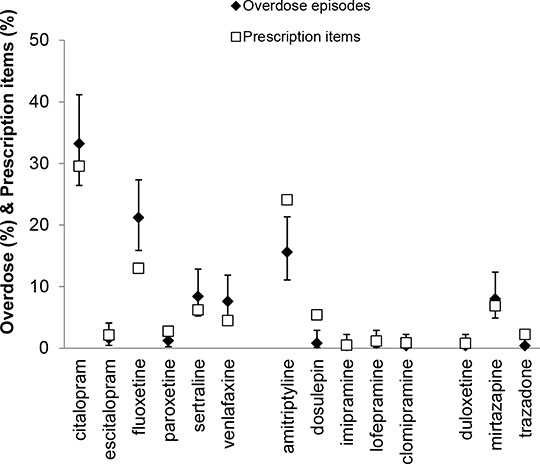Patterns of Antidepressant Prescribing and Emergency Department Attendance Due to Intentional Overdose Background Antidepressants are a common means of intentional overdose. Prescribing volumes have increased significantly in recent years and patterns of antidepressant use have changed, at least in part due to safety alerts by regulatory authorities and the availability of novel agents [1]. Few contemporary data exist concerning the impact on patterns of intentional antidepressant overdose. Aims The present study sought to examine presentations to York Hospital due to antidepressant overdose, and to compare the patterns of community prescribing in the North Yorkshire region. Methods Patients that presented to the Emergency Department in 2010 and 2011 due to intentional antidepressant overdose were studied. Corresponding prescription items in the North Yorkshire region were examined during the same period. Overdose episodes and prescription items for particular agents were expressed as proportions of all antidepressant overdose episodes and prescription items respectively. Hazard ratios were constructed by comparing the observed overdose numbers to that predicted by the proportion of all prescription items. Results There were 250 hospital presentations due to antidepressant overdose, and 1288 thousand community prescription items; the proportions of overdose episodes and prescription items involving individual agents are shown in Figure 1. Selected serotonin reuptake inhibitors had a higher than expected number of overdose presentations, hazard ratio 1.26 (95% CI 1.09-1.45, P<0.001), whereas fewer tricyclic antidepressant overdoses occurred, hazard ratio 0.56 (95% CI 0.41-0.75, P<0.001); the hazard ratio for other antidepressants was 0.89 (-0.04-0.68, P = 0.083). Figure 1. Overdose involving particular antidepressant agents expressed as a proportion (95% confidence interval) of all antidepressant overdose episodes, and prescription items expressed as a proportion of all antidepressant prescriptions.

Discussion Selective serotonin reuptake inhibitors accounted for a high proportion of all antidepressant prescribing. These agents were associated with a higher than expected number of overdose episodes, whereas tricyclic antidepressants were associated with fewer than expected overdose episodes. These findings suggest that judicious prescribing might minimise the risk of more hazardous antidepressant agents in patients that are at high risk of self-harm. Conclusions A higher number of overdose presentations involved selective serotonin reuptake inhibitors than expected from local community prescribing data, suggesting that these agents are preferentially prescribed in patients at risk of intentional overdose. Further work is required to understand the factors that influence antidepressant prescribing so as to minimise the risk of self-harm with these agents.
Reference 1. Waring WS. Clinical use of antidepressant therapy and associated cardiovascular risk. Drug Healthc Patient Saf. 2012;4:93-101.
|


